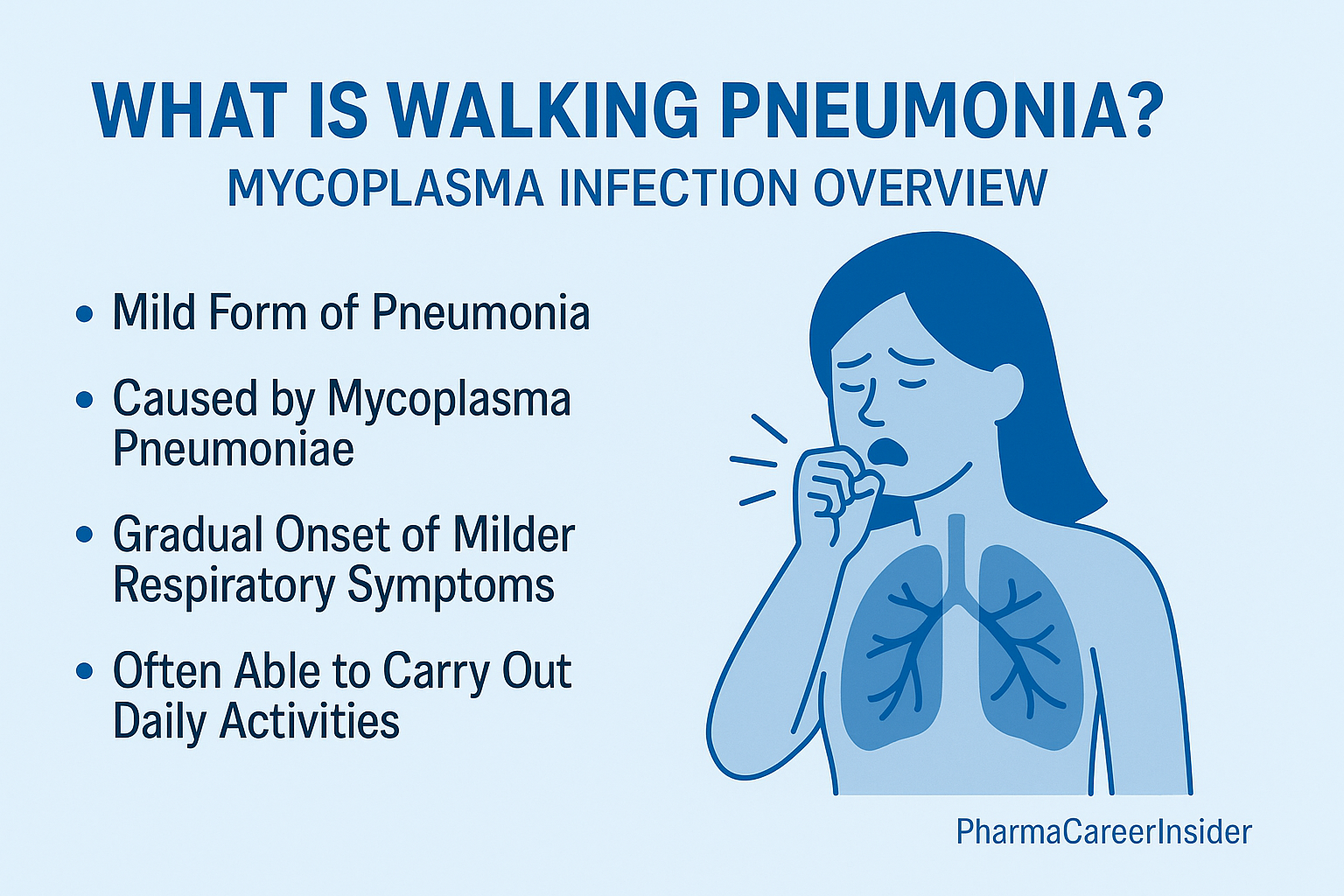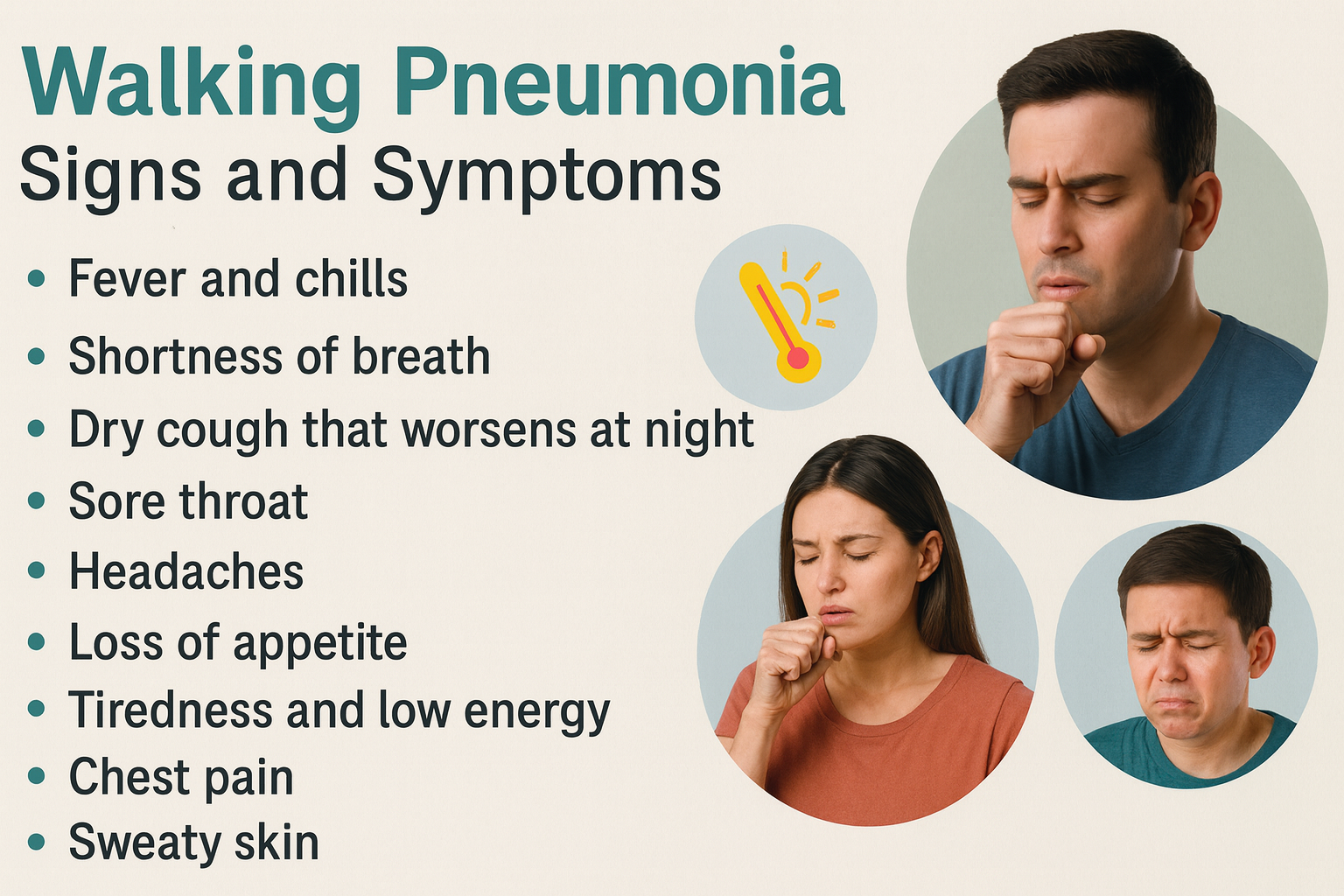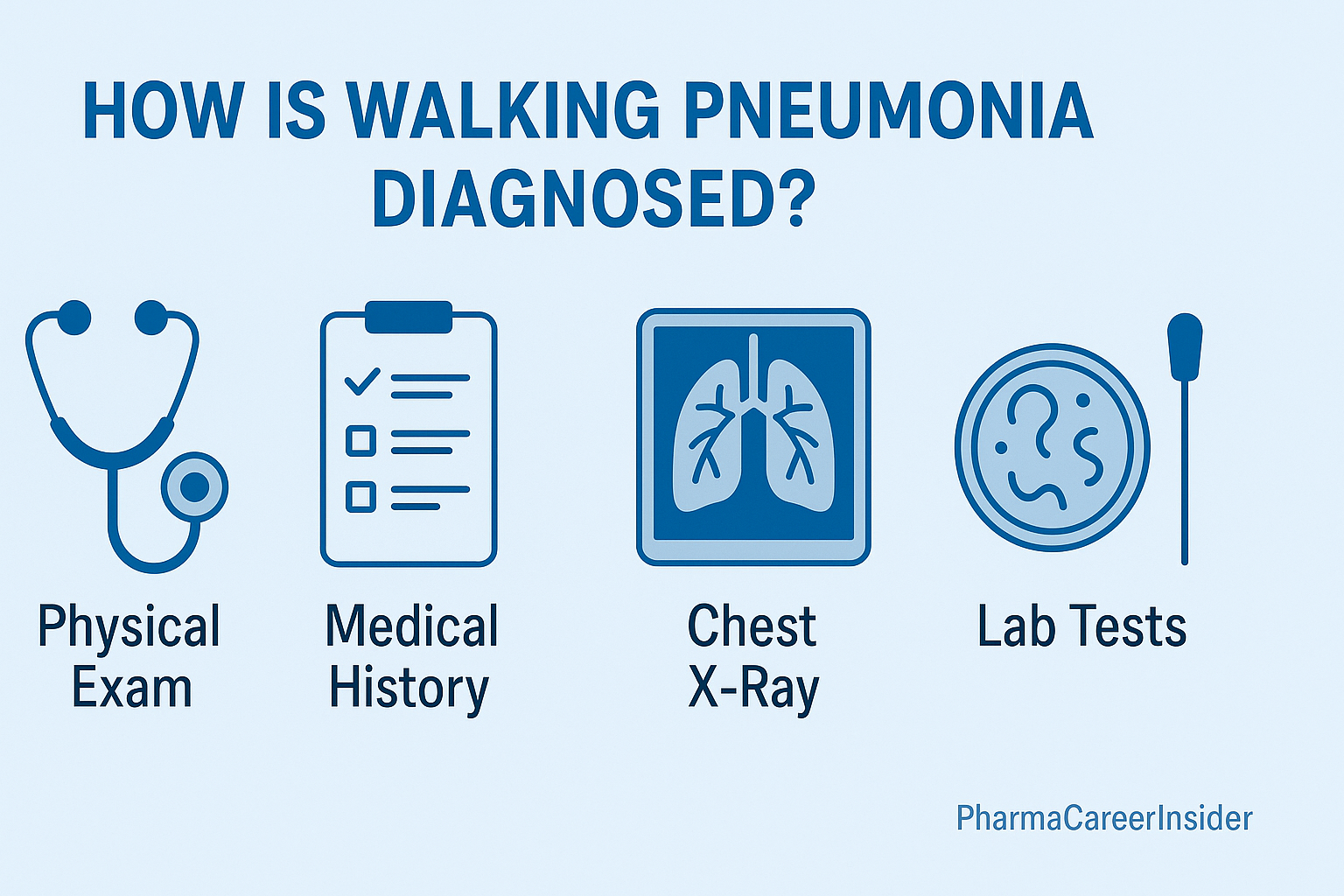Walking pneumonia, also known as Mycoplasma pneumoniae infection, is on the rise rapidly across the United States in 2025. Schools, workplaces, pediatric clinics, urgent care centers, and pharmacies are reporting an increase in cases, especially in children and young adults. Unlike typical pneumonia, this infection causes milder but more prolonged respiratory symptoms, making it challenging to detect early. Because patients are often “well enough to walk around,” the illness earned the name “walking pneumonia.”
This article provides a complete, pharmacist-verified, USA-targeted guide covering symptoms, causes, diagnosis, treatment, medicines, OTC options, prevention, and when to seek emergency care.

What Is Walking Pneumonia? (USA Perspective 2025)
Walking pneumonia is a type of atypical pneumonia primarily caused by the bacterium Mycoplasma pneumoniae. Unlike other bacteria, Mycoplasma lacks a rigid cell wall, which makes it resistant to many common antibiotics—including penicillin and beta-lactams.
Key Features:
- Mild but persistent cough
- Slow, gradual onset
- Often mistaken for flu, cold, asthma, or allergies
- Highly contagious in crowded indoor spaces
- Infection spreads through respiratory droplets
- Most common in ages 5–25 years
- High prevalence in U.S. schools, colleges, and military settings
Why It’s Trending in the USA 2025
- Indoor winter gatherings
- Close-contact environments (schools, daycare centers)
- Post-viral immunity decline
- Seasonal temperature fluctuations
- Increased travel and public mobility
Because symptoms are subtle at first, many Americans continue daily activities, unknowingly spreading the infection.
Causes and Risk Factors in the U.S. Population
Walking Pneumonia spreads through coughing, sneezing, and close personal contact. While anyone can get infected, certain groups in the U.S. are at higher risk:
High-Risk Groups (USA 2025 Data):
- Children aged 5–17 years (highest incidence)
- College students living in dorms
- Military recruits
- People with asthma or chronic lung disease
- Smokers & vaping users
- Immunocompromised individuals
- Healthcare workers & caregivers
- People are spending long hours indoors
Seasonal Trend in the USA
Although cases occur year-round, peaks are common during:
- Fall & Winter (October–February)
- Back-to-school season
- After major holidays due to indoor gatherings
Mycoplasma infections in the U.S. follow a 2–3 year cyclical pattern, and infectious disease experts confirm an upsurge in 2025, similar to previous spikes.
Symptoms of Walking Pneumonia (In Adults & Children)
Walking pneumonia symptoms develop gradually over 1–3 weeks. Because these symptoms resemble a prolonged cold, most Americans do not seek early treatment.
Common Symptoms:
- Persistent dry cough (most common)
- Sore throat
- Headache
- Fatigue and weakness
- Low-grade fever
- Chest discomfort
- Shortness of breath (mild)
- Wheezing
- Night sweats
Symptoms in U.S. Children:
- Irritability
- Loss of appetite
- Fast breathing
- Trouble sleeping
- Ear infections (Mycoplasma can cause otitis media)
Red Flags (Emergency Care Needed):
Call 911 or visit the ER if you notice:
- High fever >103°F
- Difficulty breathing
- Bluish lips or face
- Chest pain
- Confusion or drowsiness
- Symptoms worsening after 7–10 days
Early recognition helps prevent complications like bronchitis, sinusitis, or full-blown pneumonia.

Diagnosis of Walking Pneumonia in the USA
In the United States, diagnosis is typically done through:
1. Clinical Evaluation
Doctors listen for crackles or wheezing and examine respiratory symptoms.
2. Chest X-Ray
May show patchy “atypical” infiltrates, unlike typical pneumonia.
3. Laboratory Tests
- PCR test for Mycoplasma
- Serology (IgM/IgG antibodies)
- Complete blood count
- Pulse oximetry
Pharmacy-Based Assessment (U.S. Trend 2025)
Many U.S. pharmacies now offer:
- Rapid respiratory tests
- Symptom assessment
- Telehealth consultations
- Treatment recommendations
This makes early evaluation easier and faster.
Treatment Options: Medicines, Antibiotics & Home Remedies
Because Mycoplasma has no cell wall, common antibiotics like Amoxicillin or Augmentin do NOT work.
Effective treatment includes:
A. Prescription Antibiotics (USA Guidelines)
| Antibiotic | Who Receives It | Notes |
|---|---|---|
| Azithromycin (Z-Pak) | First-line for adults & kids | 5-day therapy; highly effective |
| Doxycycline | Adults & teens ≥12 years | Avoid in pregnancy |
| Fluoroquinolones (Levofloxacin, Moxifloxacin) | Adults only | Reserved for severe cases |
B. OTC Medicines (Pharmacist Recommended)
- Cough suppressants (Dextromethorphan)
- Expectorants (Guaifenesin)
- Pain relievers (Ibuprofen or Acetaminophen)
- Nasal saline sprays
- Humidifiers for congestion relief
C. Home Remedies (Evidence-Based)
- Warm fluids
- Saltwater gargles
- Steam inhalation
- Honey + warm water
- Extra rest
- Hydration (electrolytes recommended)
Recovery Time:
Most people in the USA recover in 2–4 weeks, but the cough can persist for 6–8 weeks.

Prevention: How to Protect Yourself in the USA
Walking pneumonia spreads easily in indoor U.S. environments.
Preventive strategies include:
Hygiene Measures:
- Wash hands frequently
- Avoid touching the face
- Use hand sanitizers in crowded places
Environmental Measures:
- Improve ventilation indoors
- Use air purifiers
- Wear a mask in crowded or poorly ventilated spaces
Lifestyle Measures:
- Strengthen immunity with a healthy diet
- Take Vitamin C, Zinc, and Vitamin D3
- Avoid smoking & vaping
- Stay hydrated
For Schools & Parents:
- Keep sick children at home
- Disinfect surfaces regularly
- Teach kids cough etiquette
For High-Risk Adults:
- Annual flu vaccine
- COVID booster
- Regular health check-ups
When to See a Doctor or Pharmacist in the USA
Consult a doctor if:
- Symptoms last more than 10 days
- Difficulty breathing
- Wheezing or asthma flare
- High fever
- Persistent cough >3 weeks
- Chest pain
Consult a Pharmacist For:
- OTC medication guidance
- Cough control options
- Asthma inhaler use
- Drug interaction check
- Antibiotic counseling
Emergency Room Visit Needed If:
- Severe breathlessness
- Rapid heart rate
- Severe chest pain
- Confusion or dizziness
- Bluish skin or lips
Early medical attention prevents complications like:
- Full pneumonia
- Bronchitis
- Asthma exacerbation
- Ear infections
- Hospitalization
Conclusion
Walking pneumonia is increasingly common across the USA in 2025, affecting children, teenagers, and adults alike. Although generally mild, it can cause prolonged symptoms and significant discomfort. Early detection, correct antibiotic use, and preventive measures are essential to control its spread. With proper care, most Americans recover fully within a few weeks.
Understanding symptoms, treatment options, and when to seek medical help empowers families, students, and workers to stay healthy during this ongoing respiratory season.
Frequently Asked Questions
Q1. What is the first sign of walking pneumonia?
Answer: The earliest and most common first sign is a persistent dry cough that doesn’t improve even after cold or flu medicines. Many people also report fatigue, mild fever, and throat irritation during the first few days. Symptoms appear slowly over 1–3 weeks, which is why people often don’t realize they have pneumonia.
Q2. How long does walking pneumonia last in adults?
Answer: In most adults in the USA, walking pneumonia lasts 2 to 4 weeks, but the cough can continue for 6–8 weeks. Recovery time depends on age, immunity, and whether antibiotics such as azithromycin or doxycycline are started early.
Q3. What medicine treats walking pneumonia?
Answer: Since Mycoplasma bacteria lack a cell wall, common antibiotics like amoxicillin or Augmentin do NOT work.
The effective antibiotics are
- Azithromycin (Z-Pak)—first choice for adults & children
- Doxycycline—for adults & teens
- Levofloxacin/Moxifloxacin—for severe cases only
OTC medicines like dextromethorphan (cough suppressant) and ibuprofen help reduce symptoms but do not cure the infection.
Q4. Is walking pneumonia contagious?
Answer: Yes. It is highly contagious, especially in:
- schools
- daycare centers
- college dorms
- offices
- crowded indoor spaces
Mycoplasma spreads through coughing, sneezing, talking, and close contact. A person remains contagious for up to 10 days after symptoms begin.
Q5. When should I see a doctor for walking pneumonia?
Answer: See a doctor if you have:
- fever lasting more than 3 days
- cough lasting over 10 days
- chest pain
- difficulty breathing
- wheezing
- Symptoms are worsening instead of improving
Emergency care is required if you notice bluish lips, severe shortness of breath, confusion, or chest tightness.



